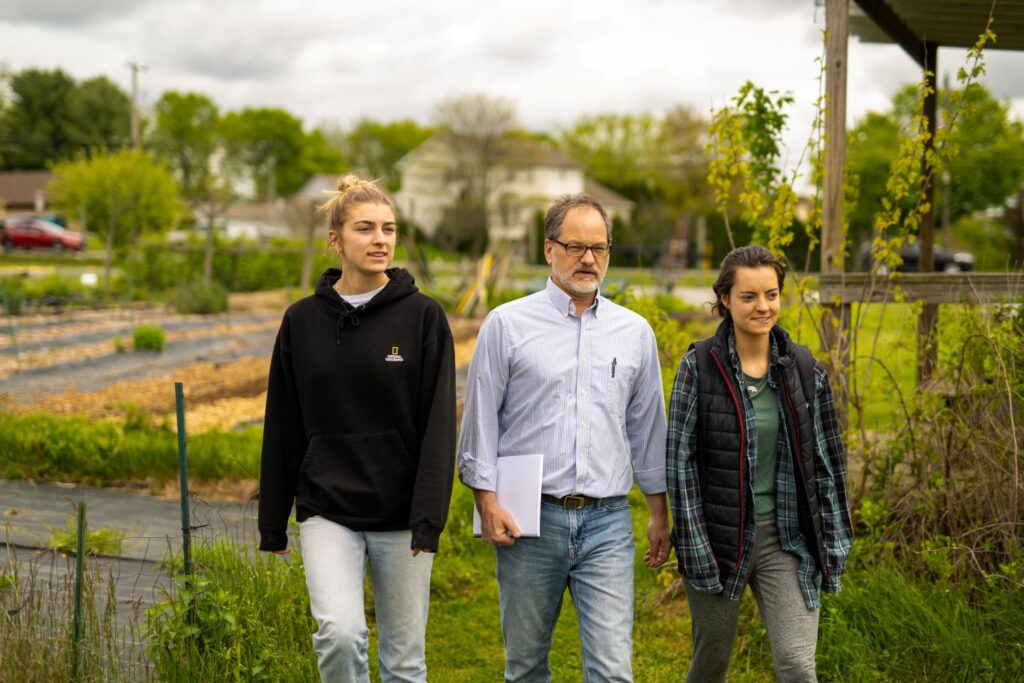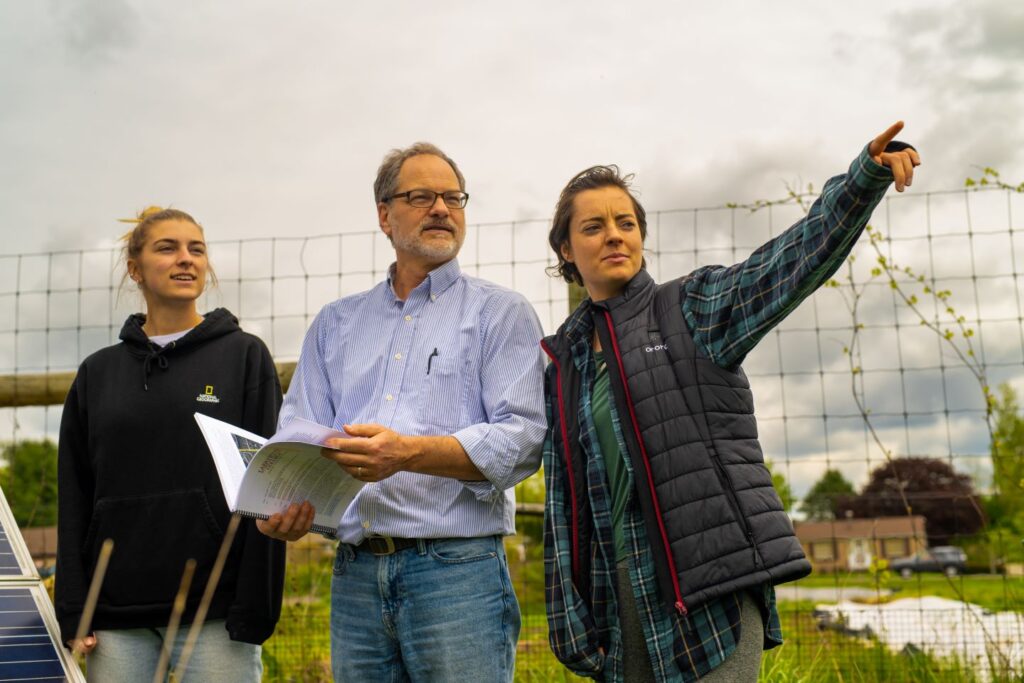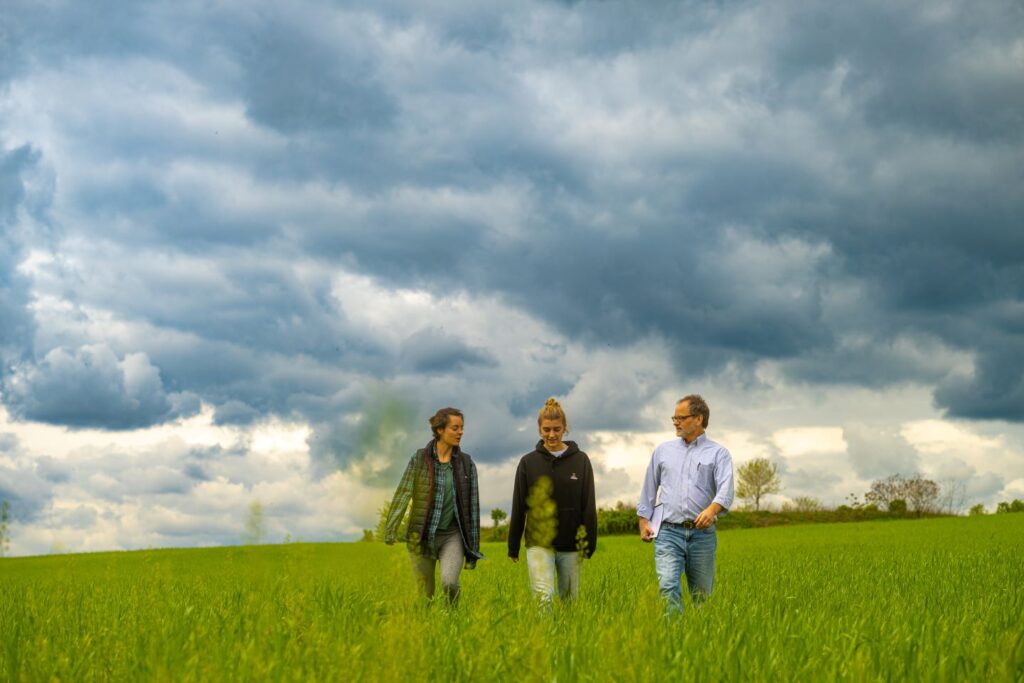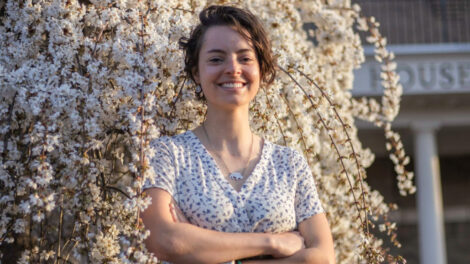Class report details path to carbon neutrality at Metzgar Fields
By Bryan Hay
The collective talent, optimism, and visionary innovation of the integrative engineering program has led to a detailed plan to achieve carbon neutrality at Metzgar Fields, including permanent ways to display Lafayette’s commitment to environmental stewardship.
Based in part on Lafayette’s 2019 Climate Action Plan, which calls for carbon neutrality at Metzgar Fields by 2025 and for the entire campus by 2035, the 92-page report recommends specific actions to achieve the 2025 goal at Metzgar while maintaining existing uses at the athletic facilities and LaFarm.

Olivia Zoretic ’24, Prof. David Brandes, and Rachel Hurley ’23 at LaFarm
Accessible from Sullivan Trail in neighboring Forks Township, Lafayette’s Metzgar Fields encompasses about 200 acres, 80 of which are used for sports facilities and LaFarm. A welcoming, sun-swept property, the fields, about 3 miles northwest of the main campus, are home to several Lafayette outdoor sports programs, including cross country, field hockey, baseball, football, soccer, lacrosse, softball, and track and field, with seating for more than 1,000 spectators, and Kamine Varsity House.
Among the proposals presented by David Brandes, professor of civil and environmental engineering and Walter A. Scott Chair of Integrative Engineering, and students in his ES 303 course (Environment and Energy Systems) are establishing a Metzgar Environmental Sustainability Center, installing solar panels, micro wind turbines and a geothermal heat pump, improving water use and management at LaFarm, and reforestation of 25 acres of unused farmland on the southern end of the property to absorb carbon dioxide.
There’s nothing hypothetical or unattainable in the report, Brandes says.
“Carbon is totally feasible to offset with the methods outlined in the report,” he says. “The reality is if you look at our total carbon emissions and what’s happening at Metzgar, it’s a small fraction of the total. My feeling is if we can’t make it happen at Metzgar, we’re in trouble as a campus.”

Olivia Zoretic ’24, Prof. David Brandes, and Rachel Hurley ’23 review their carbon reduction plan at Metzgar Fields
With data already documented in the report, available tax credits for green energy systems, and material costs starting to drop, particularly for solar panels, Brandes hopes to see many of the proposals initiated within the next few years.
“There’s more than enough land capacity for both photovoltaics and foresting to address energy and carbon concerns,” says Liam Thompson ’24.
“At Metzgar, not only can we make the facilities carbon neutral, but there is also potential to start addressing clean energy and carbon offsets on the main campus,” he says. “Bringing student-led ideas to life on campus that both tie into the content we learn in our curriculum and support the ideals we carry as a college would be an incredible example of the culture here at Lafayette.”
Brandes and his students, who each took on a section of the report, submitted their plan to President Nicole Hurd, Sherryta Freeman, director of athletics, Delicia Nahman, director of sustainability, and the SmithGroup, the architecture, facilities, and space planning firm that’s helping Lafayette facilitate its Campus Master Plan.
A particularly bold recommendation is the Metzgar Environmental Sustainability Center, which is envisioned as a living laboratory and learning center. An idea that didn’t surface in the Climate Action Plan, it would “encapsulate the essence of our project and the sustainability goals at Lafayette,” the report states.
“The Metzgar Environmental Sustainability Center can be a place where students and faculty can hold classes, club meetings, and do research while being close to nature,” says Olivia Zoretic ’24. “We also want it to be a place where outside schools, organizations, and community members can come to learn about sustainability, regenerative farming, and renewable energy.”
While working through how to resolve the sustainability issues at Metzgar, the students decided that there needed to be a place that can display the green initiatives Lafayette is making. The Metzgar Center, Zoretic notes, would be built into the slope of a hill behind LaFarm to increase insulation and reduce energy costs.
“When we estimated our current emissions, we had to figure out how much we needed to offset,” Brandes says. “And then we also developed this idea that if we’re going to do all this stuff out there, why not have an environmental sustainability center, a place where there might be a little bit of office space, a place for teaching, a place that would incorporate some new ideas, maybe built there. You’d have a space out there for teaching in sort of a central location for all these different technologies that would be integrated there.”

Olivia Zoretic ’24, Prof. David Brandes, and Rachel Hurley ’23 discuss their carbon reduction plan at Metzgar Fields
Reforestation, another innovative idea for Metzgar Fields presented in the report, would not only help remove carbon dioxide but also improve the quality of life for nearby residents and provide science-focused educational opportunities related to trees, complementing the collection of 89 tree species on the main campus.
Reforestation also would help restore the ecosystem affected by years of commercial farming, and reduce erosion in the limestone-rich soil and help mitigate sinkholes, a recurring problem at Metzgar Fields. Students could become involved in the maintenance of the trees and study the effects of reforestation on the surrounding environment
“Lafayette would become a leading member in the race to environmental sustainability and resilience if it instates an on-site solution to its carbon emissions,” the report says.
“An achievement of this project was that it was a whole class effort, and everyone was able to focus on a component of a Net Zero Metzgar that was most interesting to them,” says Rachel Hurley ’23. “I greatly appreciate Prof. Brandes, as he presented us with a unique opportunity to work toward a vision of an improved Metzgar that realistically can be implemented by the College and can be a crucial component to achieve the goals of the Climate Action Plan.”
Agrophotovoltaics, where crops are grown around elevated solar panels, also grabbed Hurley’s interest.
“We are all familiar with solar energy as a source of renewable energy; however, it is important to recognize that we can take that next step to make existing energy systems even better,” she says. “Thus, I looked beyond traditional solar fields, which are prone to inefficiencies, to a low-impact design that incorporates native vegetation. This provides additional benefits, as it doesn’t disrupt the landscape or existing plants, and promotes a pollinator habitat space that can also be maintained with sheep grazing, negating the need for fossil fuel-powered mowers.”
In addition, Hurley examined how solar panel systems can be combined with crop production into a comprehensive design that improves both crop production and panel efficiency.
“Therefore, through this project, I learned about the importance of a systems approach to renewable energies,” she adds. “The combination of solar energy harvesting, crop production, and the preservation of native habitats is important to optimizing the land use out at Metzgar.”
Thompson says he valued the experience because it brought together a like-minded team focused on a singular project.
“It was a really nice change of pace to be working on something that felt like it really mattered,” he says.
For Brandes, the multilayered work put into the report illustrated the intent of the Engineering Division’s new integrated engineering degree program, which offers students the opportunity to study emerging and interdisciplinary fields of engineering.
The project combined solar panels, which seem related to electrical engineering, and reforestation, but sounds nothing like an area of engineering, along with areas such as geothermal heat and water improvements.
“Students are having to bring to bear a variety of skills and put it together in an integrated package,” Brandes says. “That’s the real value of it, to see how the things that they’re learning in their coursework now apply to something that’s a real project, a microcosm of what society is facing. A lot of them see the connections to their future careers because many of them will probably be working in these fields.”
Working on such a satisfying project, exploring solutions, and documenting interesting and achievable goals and ideas are what teaching is all about.
“This is one reason why it’s great to be a professor,” Brandes says. “It keeps you young being around people who are bright, enthusiastic, and want to be part of the solution.”

